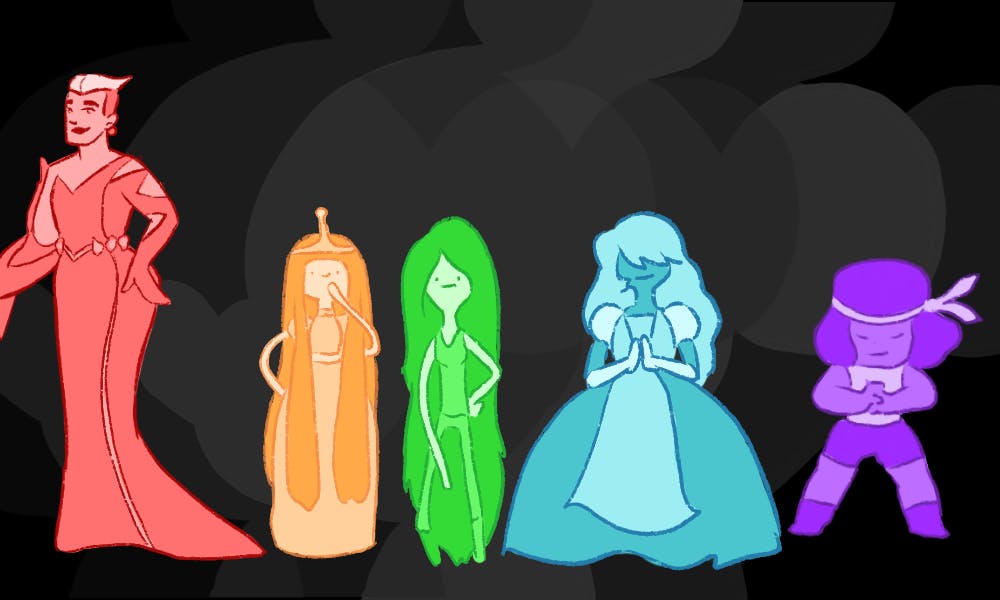In 2012, Laika Films released ParaNorman. I remember watching it when it came out—I was eleven years old and nearly missed the throwaway line at the very end confirming that the character Mitch, a stereotypical “dumb jock,” had a boyfriend. Even at that age I recognized how novel it was for any of the characters to be in a same sex relationship. It was the first mainstream animated film featuring a gay main character.
In 2014, Nickelodeon’s The Legend of Korra continued as the first western children’s animated show to have an LGBT protagonist. Shows such as Nickelodeon’s The Loud House and Cartoon Network’s Adventure Time have also integrated LGBTQ representation, showing same–sex parenting and bisexual representation, respectively. PBS made headlines this year after one of the main characters in its long running series Arthur, Mr. Ratburn, married his partner Patrick.
Cartoon Network’s Steven Universe too broke barriers with its LGBTQ representation. When its main characters, the gems, fuse together, they go by non–binary or gender–fluid pronouns.The creator of Steven Universe, Rebecca Sugar, who identifies as bisexual and non–binary herself, has spoken repeatedly about her goal to create an LGBTQ show geared toward younger audiences.
Netflix’s She–Ra and the Princesses of Power continues in this vein of female–centric, unabashedly queer storytelling. She–Ra and the Princesses of Power is not only a princess show but a superhero show too, and it shows children that queer identity can be celebrated in both of these genres. The show will also be introducing a non–binary character in its fourth season.
It's definitely heartening to see the diverse array of LGBTQ representation in children’s television, especially when it comes hand–in–hand with other forms of diversity. Yet, with all this progress made, there is still one huge company that's lagging behind: Disney.
Disney, despite being a juggernaut in media production, has hardly made a dent in LGBTQ representation with its original children’s content.
When Finding Dory released a trailer in 2016 showing two women with a toddler, many assumed this would be a lesbian couple, a groundbreaking achievement for Disney. The creative team behind the film did not confirm or deny this assumption, letting it remain ambiguous. Disney repeatedly continues this pattern with its LGBTQ representation, leaving it as ambiguous, brief, and noncommittal as possible.
There’s a confirmed same–sex couple in Zootopia and a canonical gay character in How to Train Your Dragon 3, both extremely popular films. But you probably didn't know it, because each of these characters' LGBTQ identities was confirmed retroactively and they were hardly on–screen.
LeFou, from the 2017 live–action remake of Beauty and the Beast was supposed to be Disney’s first “openly” gay character, but there was nothing in the actual film confirming his identity. Every time Disney has supposedly included a queer character, any evidence of said queer identity was easily missed or misconstrued. Disney uses LGBTQ representation to drum up interest, but ultimately forces its audiences to draw its own conclusions.
That’s not to say there isn’t hope for Disney entertainment—in 2017, the live–action Disney channel show Andi Mack had a celebrated coming out storyline for one of its main protagonists. But as amazing as such representation is, it is hardly groundbreaking.
Despite its influence, Disney refuses to take risks when it comes to positive LGBTQ representation (much can be said on how many Disney villains are queer–coded, which can perpetuate negative stereotypes). If ParaNorman could get it done with just one line, it should not be that difficult for Disney to do better.
LGBTQ representation in children's media should be unabashedly positive. It should never fall back on stereotypes or homophobic and transphobic punchlines. Characters meant for the enjoyment of children should not suffer for their identities, because young children are watching what may be their first encounter with queer identity. A character's LGBTQ identity should be integrated as a casual part of the show's world and a small part of a character's greater story arc or identity—not as a vehicle for conflict.
LGBTQ characters should also have meaningful story arcs important to the overall narrative. Showing a same–sex couple on screen for one second to get representation brownie points is not good representation. If you can replace a given character with a lamp, they're not well–written. Finally, LGBTQ representation needs to be clear and confirmed on–screen. Children aren't following these shows or films off–screen, nor are they analyzing their media for its underlying subtext.
Think of the queer kid growing up watching this content, and think of what even one LGBTQ character could mean for that child. If you're writing LGBTQ media in good faith, helping that child should be your ultimate goal, and nothing should stop you from achieving it. Disney should be no exception.

